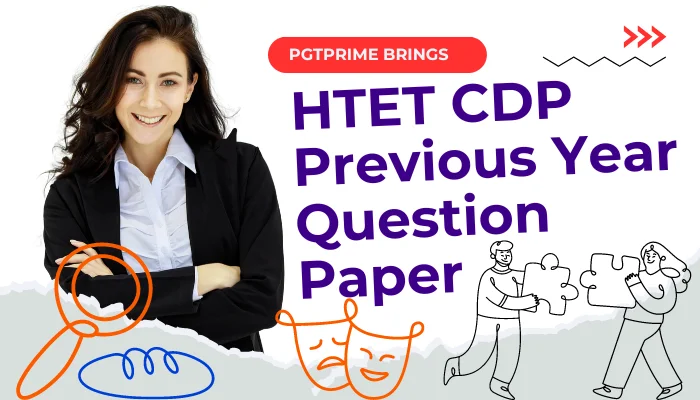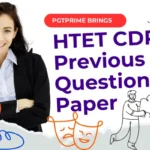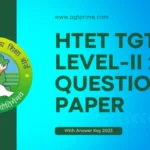It’s been a long time, but the difficulty level in HTET CDP previous year question paper holds good. And, especially when it comes to preparing Child Development & Pedagogy. This section is special for people who want to revise from the previous year’s questions and answers.
It is noticed that all HTET 2021, 2022 & 2023 PGT/Level-III question papers had the same set of CDP questions. So, the beauty is that you can discuss these 30 questions with students from any stream. In fact, this subject needs more discussion rather than a self-centered study approach.

Dedicated to
Neeraj Chopra, Manu Bhaker, Sarabjot Singh, Swapnil Kusale, Aman Sehrawat, and the Indian hockey team contributed to the six medals, including a silver and five bronze, that India won in the Paris 2024 Olympics, ranking the country in the 71st place on the medals tally.
Images imprint our minds better than text. Therefore we have linked some of the explanations with Wikipedia so that you can reap the benefit of the most organized information online. Now let’s start…
Don’t forget to check it out: HTET PGT/Level 3 Previous Question Papers 2023.😜
HTET/Level-III 2023 CDP Question Paper with Explanations
1. Which type of education would be appropriate for socially deprived children?
- Informal education
- Special education
- Inclusive education
- Religious education
Answer: HTET CDP previous year question paper
3. Inclusive education
Inclusive education refers to an educational approach where all children, regardless of their social, economic, or physical circumstances, are educated together in mainstream schools.
2. Which of the following statement is correct regarding adolescence, under Erikson’s psychosocial development theory?
- Ego identity is a positive psychosocial aspect.
- Ego identity is a negative psychosocial aspect.
- Ego identity is a neutral psychosocial aspect.
- Ego identity is not just a psychosocial aspect.
Answer: HTET CDP previous year question paper
- Ego identity is a positive psychosocial aspect.
Erik Erikson developed a theory of psychosocial development that outlines eight stages, each characterized by a central conflict. During adolescence, the key conflict is “Identity vs. Role Confusion.”
3. Which of the following characteristic is not seen in a creative child?
- Divergent thinking
- Extreme curiosity
- High imaginations
- Conventional thoughts
Answer: HTET CDP previous year question paper
3. Conventional thoughts
Conventional thoughts involves thinking in a traditional, routine, or standard way, which contrasts with the innovative and original thinking associated with creativity. Creative children are more likely to think outside the box and challenge conventional ideas.
4. Which of the following characteristics does not have positive effect on the process of socialization?
- Socially approved behavior
- Playing approved social roles
- Development of social attitudes
- Development of social prejudices
Answer: HTET CDP previous year question paper
4. Development of social prejudices
This involves forming biased or negative attitudes towards certain groups of people, which can lead to discrimination and social division.
5. Vyogtsky’s ‘zone of proximal development’ refers to:
- What the child can do independently
- What the child can’t do independently
- What the child can do with guidance of knowledgeable person
- What the child can’t do even under guidance knowledgeable person
Answer: HTET CDP previous year question paper
3. What the child can do with guidance of knowledgeable person
This concept, introduced by Lev Vygotsky, represents the difference between what a child can achieve independently and what they can achieve with assistance from someone more knowledgeable, such as a teacher, parent, or peer.
6. If a learner does not achieve the expected performance, what type of testing is done to find out the reason?
- Formative
- Diagnostic
- Remedial
- Summative
Answer: HTET CDP previous year question paper
2. Diagnostic
This type of assessment is specifically designed to identify the underlying reasons why a learner is struggling to achieve the expected performance.
7. “Inclusion is not confined to the disabled but it also means no exclusion of any child.” This meaning of inclusion in education has been clarified by:
- NCF 2005
- NCERT
- UNESCO
- UNICEF
Answer: HTET CDP previous year question paper
- NCF 2005
NCF 2005 (National Curriculum Framework 2005), developed by the National Council of Educational Research and Training (NCERT), emphasizes inclusive education. It advocates for the inclusion of all children, regardless of their physical, intellectual, social, emotional, linguistic, or other differences.
8. Which type of changes occur in growth and development?
- Change in body size
- Change in body proportion
- Disappearance of old features
- Acquisition of new features
Code: HTET CDP previous year question paperon Paper
- (a), (b) & (c)
- (a), (b) & (d)
- (a), (c) & (d)
- (a), (b), (c) & (d)
Answer: HTET CDP previous year question paper
4. (a), (b), (c) & (d)
Now, let’s analyze the options:
- Option (a): Change in body size, change in body proportion, and disappearance of old features. This covers all the relevant aspects.
- Option (b): Change in body size, change in body proportion, and acquisition of new features. Again, this covers the necessary points.
- Option ©: Change in body size, disappearance of old features, and acquisition of new features. This misses out on the change in body proportion.
- Option (d): All of the above—change in body size, change in body proportion, disappearance of old features, and acquisition of new features. This is the most comprehensive answer.
Therefore, the correct answer is option (4) – All of the above (a), (b), (c) & (d)
9. Which of the following statements does not explain the positive impact of motivation or learning?
- Motivation impairs learning behavior
- Motivation provide definite direction to learning behavior
- Motivation energizes luck in behavior
- Motivation makes learning behavior selective
Answer: HTET CDP previous year question paper
- Motivation impairs learning behavior
This statement is incorrect because motivation is generally seen as enhancing learning behavior, not impairing it.
10. Match the stages of morality with their levels, under the Moral Development theory of Kohlberg:
| Stages of Morality | Level of Morality |
|---|---|
| (a) Good interpersonal relations | I |
| (b) Individualism and exchange | II |
| (c) Social contracts and individual rights | III |
| (d) Universal principles |
Choose the correct code:
Code:
| (a) | (b) | (c) | (d) | |
| 1) | I | III | II | I |
| 2) | III | II | III | I |
| 3) | II | III | I | II |
| 4) | II | I | III | III |
Answer: HTET CDP previous year question paper
(2) (a)-III, (b)-II, (c)-III, (d)-I.
The correct code is Code 2 (III, II, III, I). Here’s the explanation:
- Stage I (Pre-conventional): This stage is characterized by a focus on self-interest and avoiding punishment. It includes individualism and exchange.
- Stage II (Pre-conventional): In this stage, individuals consider their own needs and the needs of others. It’s about reciprocity and fairness.
- Stage III (Conventional): Social contracts and individual rights are emphasized here. People at this stage recognize the importance of societal norms and rules.
- Stage III (Conventional): Universal principles come into play. Individuals consider ethical principles that transcend specific situations.
11. When the learner learns a task automatically, without any desire or purpose, then it is called:
- Massed learning
- Whole learning
- Part learner
- Incidental learning
Answer: HTET CDP previous year question paper
4. Incidental learning
This occurs when learning happens unintentionally or without a specific goal. The learner picks up information or skills as a byproduct of engaging in an activity, often without being consciously aware of the learning process.
12. Which of the following statement is not true regarding biological motives?
- They are universal
- They are inborn
- They are essential to survival
- They are not related with homeostasis in the individual
Answer: HTET CDP previous year question paper
4. They are not related with homeostasis in the individual
Biological motives are closely related to homeostasis, which is the body’s mechanism to maintain internal stability (such as regulating body temperature, hunger, and thirst).
13. Which of the following examinations are the basis of continuous and comprehensive evaluation?
- Written
- Oral
- Behavioral
- Practical
Choose the correct code :
Code :
- (a), (b) & (d)
- (a), (b) & (c)
- (a), (c) & (d)
- (a), (b), (c) & (d)
Answer: HTET CDP previous year question paper
(4) (a), (b), (c) & (d)
Now, let’s analyze the options: HTET CDP previous year question paperon Paper
- (a), (b) & (d): This combination includes written, oral, and practical assessments. It covers a comprehensive range of evaluation methods, so it’s a strong possibility.
- (a), (b) & ©: This combination includes written, oral, and behavioral assessments. While it covers different aspects, it doesn’t include practical assessments.
- (a), © & (d): This combination includes written, behavioral, and practical assessments. Again, it lacks oral assessments.
- (a), (b), © & (d): This combination includes all four types—written, oral, behavioral, and practical assessments. It covers the entire spectrum of evaluation methods.
The correct code is (a), (b), (c) & (d)—which means all four types of assessments are part of continuous and comprehensive evaluation.
14. Which of the following statement is not corrected in reference to intelligent tests?
- Alexander’s pass along test is a performance test.
- verbal test can be either individual or group.
- Illiterate people cannot do performance test.
- In non-verbal tests intelligence is measured through pictures and figures.
Answer: HTET CDP previous year question paper
3. Illiterate people cannot do performance test.
Performance tests are specifically designed to measure intelligence without relying on reading or writing skills. These tests assess problem-solving abilities, spatial awareness, and other cognitive functions using tasks that do not require literacy, making them suitable for illiterate individuals.
15. Which of the following pair is not correct regarding elements of intelligence and their dimension under the Three Dimensional Intelligence theory of Guilford?
| Elements of intelligence | Dimension |
|---|---|
| 1) Unit | Product |
| 2) Cognition | Operation |
| 3) Evaluation | Operation |
| 4) Relations | Content |
Answer: HTET CDP previous year question paper
(4) Relations – Content
According to J.P. Guilford’s Three-Dimensional Intelligence theory.
- Unit: This refers to the ability to recognize individual elements or components. The correct dimension associated with “Unit” is Product.
- Cognition: This involves mental processes such as thinking, reasoning, and problem-solving. The correct dimension associated with “Cognition” is Operation.
- Evaluation: This pertains to the ability to judge or assess information. Again, the correct dimension associated with “Evaluation” is Operation.
- Relations: This refers to understanding connections or patterns between different elements. The correct dimension associated with “Relations” is Content.
Therefore, the incorrect pair is “Relations” and “Content.” In Guilford’s theory, “Relations” should be associated with the dimension of “Product.”
Don’t forget to check it out: HTET PGT/Level 3 Syllabus.😜
16. Which one of the following is not a key feature of child centered learning approach?
- Meaningful learning opportunities
- Single learning pathway
- Continuous assessment
- Accessible learning settings
Answer: HTET CDP previous year question paper
2. Single learning pathway
A single, uniform learning pathway does not align with the child-centered approach, which emphasizes personalized learning experiences.
17. According to Bandura, which is not the interrelated processes of observational learning?
- Attentional processes
- Retentional processes
- Motivational processes
- Conjunctional processes
Answer: HTET CDP previous year question paper
4. Conjunctional processes
Bandura’s model of observational learning involves four interrelated processes:
- Attentional processes
- Retentional processes
- Motor reproduction processes
- Motivational processes
18. According to Bandura’s social learning theory, what is it called when a person learns the same behavior by observing and repeating the behavior of others?
- Adaptation
- self observation
- Modeling
- Efficacy expectation
Answer: HTET CDP previous year question paper
3. Modeling
This is a core concept in Albert Bandura’s social learning theory. It refers to the process of learning behaviors by observing and imitating others.
19. Which subcomponent is not included in componential intelligence under the Sternberg Triarchic Theory?
- Meta component
- Experimental component
- Performance component
- Knowledge acquisition component
Answer: HTET CDP previous year question paper
2. Experimental component
Sternberg’s Triarchic Theory of Intelligence posits three types of intelligence:
- Componential intelligence (Analytical intelligence)
- Experiential intelligence (Creative intelligence)
- Contextual intelligence (Practical intelligence)
20. A learning disability that affects the accreditation of arithmetical skill is:
- Dyscalculia
- Dysgraphia
- Dyslexia
- Dysmagnisia
Answer: HTET CDP previous year question paper
- Dyscalculia
A specific learning disability that primarily affects a person’s ability to understand numbers and learn math facts.
21. Choose the correct sequence of the five stages of Freud’s psychosexual development theory:
- Oral stage -> phallic stage -> Latency stage -> Anal stage -> Genital stage
- Anal stage -> Latency stage -> Phallic stage -> Genital stage -> Oral stage
- Oral stage -> Anal stage -> Phallic stage -> Latency stage -> Genital stage
- Latency stage -> Anal stage -> Oral stage -> Genital stage -> Phallic stage
Answer: HTET CDP previous year question paper
(3) Oral stage -> Anal stage -> Phallic stage -> Latency stage -> Genital stage
Freud’s Psychosexual Stages:
- Oral Stage: This is the first stage, occurring from birth to around 1 year of age. During this stage, pleasure is centered on the mouth (sucking, biting, etc.). The primary conflict is weaning from breastfeeding or bottle feeding.
- Anal Stage: Next comes the anal stage, which typically spans ages 1 to 3 years. Here, the focus shifts to bowel and bladder control. The main conflict revolves around toilet training—specifically, the child’s ability to manage elimination.
- Phallic Stage: Around ages 3 to 6 years, children enter the phallic stage. This stage is marked by curiosity about their own bodies and the differences between boys and girls.
- Latency Stage: The latency stage occurs from around age 6 to puberty. During this period, sexual feelings are repressed, and children focus on developing social and cognitive skills. It’s a relatively calm phase in terms of psychosexual development.
- Genital Stage: Finally, the genital stage begins at puberty and continues into adulthood. Sexual energy is redirected toward mature, adult relationships. The focus is on forming healthy intimate connections.
22. According to Pavlov’s classical conditioning theory of learning, which temporal sequence presentation of natural and conditioned stimuli will most affect learning?
- Simultaneous
- Delay
- Trace
- Backward
Answer: HTET CDP previous year question paper
2 Delay
Delay: The conditioned stimulus-CS is presented just before the unconditioned stimulus-US and continues until the unconditioned stimulus-US is presented. This sequence is the most effective for establishing a strong association between the conditioned stimulus-CS and US.
23. In which states of Piaget’s Cognitive Development theory does the ability of abstract thinking and generalization develop?
- Sensory motor
- Pre-operational
- Concrete operational
- Formal operational
Answer: HTET CDP previous year question paper
4. Formal operational
Formal operational stage (11 years and older): This stage is characterized by the development of abstract thinking, generalization, and hypothetical reasoning.
24. Which of the following educational arrangements shouldn’t be made for talented students?
- Opportunities for independent project work
- Acceleration
- Remedial teaching
- Enrichment program
Answer: HTET CDP previous year question paper
3. Remedial teaching
This type of instruction is typically designed to help students who are struggling with the basic concepts and are performing below grade level.
25. Which one of the following is not a principle of inclusive education?
- Principle of segregation
- Principle of cooperation
- Principle of celebrating diversity
- Principle of right to education
Answer: HTET CDP previous year question paper
- Principle of segregation
This involves separating or isolating students with special needs from their peers, which is contrary to the principles of inclusive education. Inclusive education promotes the integration of all students, regardless of their abilities or disabilities, into the same learning environment.
26. Which of the following wear does not support the teaching according to individual differences?
- Large group of students
- Individualized instruction
- Curriculum adaptation
- Knowledge of students abilities
Answer: HTET CDP previous year question paper
- Large group of students
Teaching large groups makes it difficult to cater to individual differences because it limits the teacher’s ability to provide personalized attention and adapt instruction to meet the unique needs of each student.
27. Which is not a role of educational institutions in addressing the needs of children with special need?
- Admission to school without discrimination
- Provide accessible infrastructural facilities
- Identifying special needs and exclude them from mainstreaming
- Provide necessary support services
Answer: HTET CDP previous year question paper
3. Identifying special needs and exclude them from mainstreaming
Because the goal of addressing special needs is to include children in the mainstream education system whenever possible, not to exclude them.
28. Which of the following statement is not correct in context of development?
- Development is the product of maturation and learning.
- Later development is more critical than early development.
- Development proceeds from head to foot.
- Development proceeds from Central Axis to extremities.
Answer: HTET CDP previous year question paper
2. Later development is more critical than early development.
Early development, especially in the early childhood years, is considered more critical because it lays the foundation for later physical, cognitive, and emotional development.
29. The three dimensional model of the inclusive education propounded by whom?
- Griffith, Cooper and Ringlaben
- Gartuer and Lipsky
- Kauffman and Hallahan
- Levenski, Davis and Hooper
Answer: HTET CDP previous year question paper2021 CDP Question Paper
- Griffith, Cooper and Ringlaben
The three-dimensional model focuses on creating an educational environment where all students, regardless of their abilities or disabilities, can learn together. The model emphasizes three key dimensions: Physical Inclusion, Social Inclusion, Academic Inclusion.
30. “Socialization means attaining of maturity in social relationships.” This definition of socialization is given by whom?
- John Dewey
- Garret
- Sorenson
- Hurlock
Answer: HTET CDP previous year question paper
4. Hurlock
Elizabeth Hurlock, a developmental psychologist, defined socialization as the process of attaining maturity in social relationships. Through socialization, individuals develop the skills and understanding required to navigate social interactions and build meaningful relationships.
Don’t forget to check it out: HTET PGT/Level 3 Previous Question Papers 2022.😜
HTET/Level-III 2022 CDP Question Paper with Explanations
1. A type of intelligence test in which the difficulty level of questions gradually increases and the time factor is secondary :
- Verbal Test
- Power Test
- Speed Test
- Performance Test
Answer: HTET CDP previous year question paper
2. Power Test
A Power Test is a type of intelligence or ability test designed to assess the depth of a person’s knowledge, understanding, or skill in a particular area.
2. A teaching-learning strategy in which small groups of students with different level of ability use a variety of learning activities to improve their understanding of a subject :
- Multi-sensory learning
- Team teaching
- Co-operative learning
- Programmed learning
Answer: HTET CDP previous year question paper
3. Co-operative learning
Co-operative Learning involves students working together in small groups, with each member having different levels of ability.
3. Spranger’s classification of personality is related to which approach of personality assessment ?
- Trait Approach
- Type Approach
- Instinct Approach
- Psychoanalytic Approach
Answer: HTET CDP previous year question paper
2. Type Approach
This approach identifies specific, often mutually exclusive, personality types. Each type represents a distinct pattern of behavior, attitudes, and values.
4. Which of the following is not a symptom of good mental health of students ?
- Living in fantasy world
- Balance in life
- Knowledge of our potentials and limitations
- Free from undesirable worries
Answer: HTET CDP previous year question paper
- Living in fantasy world
This suggests an avoidance of reality, which can be a sign of poor mental health. Healthy individuals are generally grounded in reality, with a clear understanding of their environment and circumstances.
5. ‘When an adolescent is unable to show anger to his parents, then he shows his anger to his younger brother.’ This is an example of which type of defence mechanism ?
- Repression
- Regression
- Projection
- Displacement
Answer: HTET CDP previous year question paperCDP Question Paper
4. Displacement
This defense mechanism involves redirecting emotions or impulses from a threatening or inappropriate target to a safer or more acceptable one.
6. According to Piaget’s Cognitive Development Theory, ‘The basic unit of the cognitive structure that helps in the implementation of cognitive behaviour’, is termed as :
- Reflexes
- Basic Instincts
- Schema
- Conservation
Answer: HTET CDP previous year question paperuestion Paper
3. Schema
A schema is a cognitive framework or concept that helps individuals organize and interpret information. Schemas are the basic building blocks of cognitive development, and they guide the processing of new information by fitting it into pre-existing mental structures.
7. “Emotional Intelligence may be defined as the capacity to reason with emotion in four areas – to perceive emotion, to integrate it in thought, to understand it and to manage it.” Who gave this definition of emotional intelligence ?
- Daniel Goleman
- Mayer and Peter Salovey
- Peter and Michael
- Halverson
Answer: HTET CDP previous year question paper
2. Mayer and Peter Salovey
- Daniel Goleman popularized the concept of emotional intelligence but focused more on its role in leadership and workplace success.
- The other names, Peter and Michael and Halverson, are not associated with this specific definition of emotional intelligence.
8. Which one of the following is not a direct method for measurement of attitude ?
- Interview
- Projection
- Questionnaire
- Observation
Answer: HTET CDP previous year question paper
2. Projection
This is an indirect method, where individuals project their attitudes onto ambiguous stimuli (like in projective tests) to reveal hidden attitudes.
9. ‘A horse can be brought near water, but cannot be forced to drink.’ This statement reveals the truth of Thorndike’s which law of learning ?
- Law of Readiness
- Law of Exercise
- Law of Effect
- Law of Multi Responses
Answer: HTET CDP previous year question paper
- Law of Readiness
This law suggests that learning is most effective when a learner is physically and mentally prepared to act.
10. Which of the following is not a level of teaching ?
- Basic Level
- Memory Level
- Understanding Level
- Reflective Level
Answer: HTET CDP previous year question paper
- Basic Level
The recognized levels of teaching include: Memory Level, Understanding Level, and Reflective Level.
11. Which one of the following is not a part of Bronfenbrenner’s Ecological System theory ?
- Micro system
- Macro system
- Minor system
- Meso system
Answer: HTET CDP previous year question paper
3. Minor system
Bronfenbrenner’s Ecological System Theory includes the following systems: Microsystem, Mesosystem, and Macrosystem.
12. Which pair is not correct with reference to emotions and basic instincts ?
| Emotion | Basic Instinct |
|---|---|
| 1. Anger | Repulsion |
| 2. Ownership | Collection |
| 3. Wonder | Curiosity |
| 4. Fear | Escape |
Answer: HTET CDP previous year question paper
- Anger – Repulsion
Sigmund Freud, an Austrian neurologist, is widely recognized as the founder of psychoanalysis. His work in the late 19th and early 20th centuries laid the groundwork for this influential method of psychology.
13. Which way is the most appropriate for social development of adolescents ?
- Discussion on socialization
- Essay competition on social values
- Organizing group activities
- Documentary on social relations
Answer: HTET CDP previous year question paper
3. Organizing group activities
This is highly effective for social development as it encourages interaction, teamwork, cooperation, communication, and problem-solving among adolescents, all of which are key aspects of social growth.
14. According to Maslow’s Need Hierarchical theory, ‘Esteem Needs’ are which type of need ?
- Personal
- Social
- Intellectual
- Emotional
Answer: HTET CDP previous year question paper
1. Personal
In Maslow’s theory refer to the need for self-respect, self-esteem, confidence, achievement, and the respect of others. These needs focus on personal feelings of worth and accomplishment.
15. Which of the following task is not related to Baqer Mehdi’s test of Creativity ?
- Unusual uses related task
- New relation between pairs related task
- Product improvement related task
- Ask and guess related task
Answer: HTET CDP previous year question paper
4. Ask and guess related task
“Ask and guess related task” is not typically associated with Baqer Mehdi’s test of creativity.
Don’t forget to check it out: HTET PGT/Level 3 Syllabus.😜
16. Which of the following statement is not correct with reference to individual differences ?
- No two persons can be exactly alike.
- Individual differences may belong to different areas.
- Individual differences affects different dimensions of development.
- Individual differences arises only due to heredity.
Answer: HTET CDP previous year question paper
4. Individual differences arises only due to heredity.
While heredity plays a role in individual differences, environmental factors (such as family, culture, education, and experiences) also significantly contribute to shaping these differences.
17. Who is called the father of Trait Theory for study of personality ?
- Allport
- Woodworth
- McDougall
- Eysenck
Answer: HTET CDP previous year question paper
1. Allport
Allport emphasized the importance of individual differences and the use of traits to describe personality. He proposed that traits are enduring patterns of behavior that define an individual’s personality.
18. Which of the following pairs of communication skills is correct for receiving the information ?
- Listening and Writing
- Speaking and Reading
- Listening and Reading
- Speaking and Writing
Answer: HTET CDP previous year question paper
3. Listening and Reading
Listening: This skill involves receiving spoken information and understanding it. Reading: This skill involves receiving written information and comprehending it.
19. According to Triarchic Theory, which of the following is not a type of intelligence ?
- Analytical
- Creative
- Theoretical
- Practical
Answer: HTET CDP previous year question paper
3. Theoretical
Theory of Intelligence proposed by Robert Sternberg focuses on Analytical, Creative, and Practical intelligences.
20. According to Kohlberg’s theory, what level of morality is it, when morality includes self-accepted moral principles ?
- Pre-conventional
- Conventional
- Post-conventional
- None of these
Answer: HTET CDP previous year question paper
3. Post-conventional
In this stage, individuals base their morality on abstract principles and values that they have chosen for themselves. These principles may sometimes conflict with laws or social rules, but they are self-accepted and guide the person’s behavior.
21. Which of the following is not a general characteristic of adolescence period ?
- It is a transitional period.
- It is period of unrealism.
- It is time for search of identity.
- It is the threshold of puberty.
Answer: HTET CDP previous year question paper
2. It is period of unrealism.
While adolescents may experience idealism and explore abstract concepts, the term “unrealism” is not typically used to describe this developmental stage.
22. Who developed the Thematic Apperception Test for personality assessment ?
- Murray and Morgan
- Bellack
- Eysenck
- Allport and Cattell
Answer: HTET CDP previous year question paper
- Murray and Morgan
Henry A. Murray and Christina D. Morgan developed the Thematic Apperception Test (TAT) in the 1930s. It is a projective psychological test designed to reveal a person’s underlying motives, concerns, and the way they see the social world through the stories they make up about ambiguous pictures of people.
23. What type of reinforcement schedule is it, when reinforcement is provided to the learner only after a certain number of responses ?
- Fixed ratio
- Variable ratio
- Fixed interval
- Variable interval
Answer: HTET CDP previous year question paper
- Fixed ratio
Reinforcement is given after a specific, fixed number of responses. For example, a reward is given after every 5th correct response.
24. According to the moral development theory of Piaget, adolescence period is :
- Stage of moral realism
- Stage of morality constraint
- Stage of heteronomous morality
- Stage of autonomous morality
Answer: HTET CDP previous year question paper
4. Stage of autonomous morality
In adolescence, individuals enter the stage of autonomous morality, where they begin to understand that rules are created by people and can be changed through mutual agreement.
25. Which of the following factors positively affects learning ?
- Meaningless content
- Lack of maturation
- Lack of motivation
- Informational feedback
Answer: HTET CDP previous year question paper Question Paper
4. Informational feedback
This provides learners with specific information about their performance, helping them understand what they are doing correctly or where they need improvement.
26. Rohit helps others to get praise. This is an example of :
- Intrinsic Motivation
- Extrinsic Motivation
- Innate Motivation
- None of these
Answer: HTET CDP previous year question papertion Paper
2. Extrinsic Motivation
This occurs when a person is motivated to perform a behavior to earn rewards or avoid punishment. In this case, Rohit is helping others to receive praise, which is an external reward.
27. What will be the intelligence quotient of a 15 year old boy, when his mental age is 12 ?
- 80
- 90
- 100
- 110
Answer: HTET CDP previous year question paper
- 80
- Mental Age (MA) = 12 years
- Chronological Age (CA) = 15 years
Substituting the values: IQ=(12/15)×100=0.8×100=80 IQ
So, the IQ of the 15-year-old boy is 80.
28. As a teacher which of the following work would not be done by you to develop the creativity of the students ?
- Encouragement of originality
- Removal of fear
- Freedom to respond
- Avoidance of divergent thinking
Answer: HTET CDP previous year question paper
4. Avoidance of divergent thinking
This is counterproductive to creativity. Divergent thinking, where students explore multiple possible solutions, is a key aspect of creative thinking.
29. Development which proceeds from ‘centre to the periphery’, is known as :
- Cephalic Caudal
- Proximodistal
- Spiral
- Circular
Answer: HTET CDP previous year question paper
2. Proximodistal
This principle of development describes how growth and motor skills progress from the central axis of the body outward to the extremities. For example, infants gain control over their torso before they can control their arms and legs.
30. Hunger and Thirst is which type of motive ?
- Extrinsic
- Acquired
- Intrinsic
- Social
Answer: HTET CDP previous year question paper
3. Intrinsic
These are inborn, biological motives that arise from internal physiological states, such as hunger and thirst, which are essential for survival.
Don’t forget to check it out: HTET PGT/Level 3 Previous Question Papers 2021.😜
HTET/Level-III 2021 CDP Question Paper with Explanations
1. Who developed the first intelligence test ?
- Lavator
- Sanguin
- Francis Galton
- Alfred Binet and Simon
Answer: HTET CDP previous year question paper
4. Alfred Binet and Simon
In the early 20th century, the French government commissioned Alfred Binet to develop a method for identifying children who needed special educational assistance. Binet, along with his colleague Théodore Simon, created the Binet-Simon Scale in 1905 which is considered as first intelligence test.
2. A branch of psychology which studies how people change physically, cognitively and socially over the entire life span is known as :
- Clinical psychology
- Counselling psychology
- Developmental psychology
- Experimental psychology
Answer: HTET CDP previous year question paperper
3. Developmental psychology
This field focuses on the growth and changes that occur throughout a person’s life. Key topics on this field include motor skills, cognitive development, language acquisition, social and emotional development, personality, and identity formation.
3. Which of the following is not the innate motive ?
- Safety
- Hunger
- Thirst
- Rest
Answer: HTET CDP previous year question paper1 CDP Question Paper
- Safety
While important, safety is considered a learned motive. The desire for safety arises from experiences and the need to protect oneself from harm, rather than an inherent biological drive.
4. Who stated that “Adolescence is a period of stress, strain, storm and strife” ?
- William H. Barton
- Stanley Hall
- J. A. Hadfield
- Jean Piaget
Answer: HTET CDP previous year question paper
2. Stanley Hall
G. Stanley Hall was a pioneering American psychologist and educator who is well-known for his theory that adolescence is a period of “storm and stress,” characterized by emotional turbulence and heightened conflict.
5. Which of the following is the highest level in hierarchical theory of learning given by Gagne ?
- Problem solving learning
- Principle learning
- Concept learning
- Multiple discrimination learning
Answer: HTET CDP previous year question paper
- Problem solving learning
Robert Gagné identified different levels of learning in a hierarchy, each building on the previous one. The levels are:
- Signal learning: Learning through classical conditioning.
- Stimulus-response learning: Learning through operant conditioning.
- Chaining: Learning through linking simple behaviors into a more complex sequence.
- Verbal association: Learning through associating verbal responses.
- Multiple discrimination: Learning to distinguish between different stimuli.
- Concept learning: Learning through categorizing and recognizing common characteristics.
- Principle learning: Learning through understanding relationships and principles.
- Problem solving learning: The highest level, involving applying learned principles and concepts to solve new and complex problems.
6. Which of the following is the non projective technique of personality measurement ?
- Association technique
- Sociometric technique
- Construction technique
- Completion technique
Answer: HTET CDP previous year question paperper
2. Sociometric technique
This technique used to measure social relationships and dynamics within groups. The data collected helps in understanding social structures, peer relationships, and group dynamics.
7. Which of the following is not the characteristic of good mental health ?
- Emotional maturity
- Self confidence
- Intolerance
- Capacity of self evaluation
Answer: HTET CDP previous year question paper
3. Intolerance
Intolerance refers to the unwillingness to accept views, beliefs, or behaviors that differ from one’s own. This may lead to conflict and stress.
8. Which of the following concept is not introduced by Jean Piaget in his Cognitive Development theory ?
- Assimilation
- Accommodation
- Symbolic
- Equilibration
Answer: HTET CDP previous year question paper
3. Symbolic
“symbolic” itself is not a core concept of his theory. Instead, it’s more about the ability to use symbols rather than a fundamental principle like assimilation, accommodation, and equilibration.
9. Which one of the following stage is not prescribed by James Draver in the context of development of character ?
- The stage of crude emotion
- The stage of sentiment
- The self regard stage
- Conforming conventional stage
Answer: HTET CDP previous year question paper
4. Conforming conventional stage
The stage of crude emotion does not align with Drever’s more refined approach to the stages of character development, which typically focus on more complex emotional and social constructs rather than basic or “crude” emotions.
10. Who was the founder of socio-culture theory of cognitive development ?
- Jean Piaget
- Jerom Bruner
- Lev Vygotsky
- Kohlberg
Answer: HTET CDP previous year question paper
3. Lev Vygotsky
Vygotsky was a Russian psychologist who developed the socio-cultural theory of cognitive development. This theory emphasizes the fundamental role of social interaction in the development of cognition.
11. Which of the following is not the type of projective technique of personality measurement ?
- Word Association Test
- Woodworth’s Personal Data Sheet
- Sentence Completion Test
- Thematic Apperception Test
Answer: HTET CDP previous year question paper
2. Woodworth’s Personal Data Sheet
Projective techniques are used to uncover the hidden aspects of an individual’s personality. They involve presenting ambiguous stimuli to the person and interpreting their responses to uncover underlying thoughts, feelings, and motivations.
12. Which of the following is not the type of dynamic trait of personality given by Cattell ?
- Attitude
- Urge
- Sentiment
- Conservative
Answer: HTET CDP previous year question paper
4. Conservative
Raymond Cattell identified dynamic traits as motivators that drive behavior and can be divided into three categories: Attitudes, Sentiments, and Ergs (often referred to as urges or innate drives).
13. For which age group the Children Apperception Test (CAT) is applicable ?
- 2 to 5 yrs.
- 0 to 4 yrs.
- 16 to 18 yrs.
- 3 to 10 yrs.
Answer: HTET CDP previous year question paperuestion Paper
4. 3 to 10 yrs.
The Children Apperception Test (CAT) is a projective psychological test designed to assess the personality, emotional functioning, and social attitudes of children within this age range through series of pictures depicting animals in various human-like situations. This method helps reveal the child’s inner thoughts, feelings, and concerns.
14. Which of the following is not the characteristic of Adolescence ?
- Weight of muscles is 20% of total weight of body.
- Tendency of day dreams increased.
- Vocabulary too increases.
- Mental abilities reach at their highest level.
Answer: HTET CDP previous year question paper
- Weight of muscles is 20% of total weight of body.
This characteristic is not typically associated with adolescence. The Characteristics of Adolescence: Tendency of day dreams increased, Vocabulary too increases, Mental abilities reach at their highest level.
15. Which of the following is the false characteristic of motivation ?
- In motivation, behaviour of person is goal oriented.
- Motivated behaviour does continuity.
- Nature of motivated behaviour is rigid.
- Motivation does energy changes in human beings.
Answer: HTET CDP previous year question paper
3. Nature of motivated behaviour is rigid.
True Characteristics of Motivation: In motivation, behaviour of person is goal-oriented, Motivated behaviour does continuity, Motivation does energy changes in human beings.
Don’t forget to check it out: HTET PGT/Level 3 Syllabus.😜
16. According to Stanford-Binet IQ scale, what is the IQ range of low mentally retarded children ?
- 52 to 67
- 36 to 51
- 20 to 35
- below 20
Answer: HTET CDP previous year question paper
- 52 to 67
The Stanford-Binet IQ scale classifies intellectual disability into several categories based on IQ scores:
- Mild Intellectual Disability (IQ 52 to 67)
- Moderate Intellectual Disability (IQ 36 to 51)
- Severe Intellectual Disability (IQ 20 to 35)
- Profound Intellectual Disability (IQ below 20)
17. Who was the propounder of Anticipatory theory of play ?
- Karl Groos
- McDougall
- Herbert Spencer
- G. Stanley Hall
Answer: HTET CDP previous year question paper
- Karl Groos
Karl Groos, a German philosopher and psychologist, suggests that play is a form of practice for adult activities. Through play, children develop skills and behaviors that are important for their future roles as adults.
18. Out of the following which one is the wrong statement in context of characteristics of habits ?
- Habit is automatic response to specific situation.
- Habit is acquired through heredity.
- Habit is a well learned performance.
- Habit is performed only under similar circumstances.
Answer: HTET CDP previous year question paper
2. Habit is acquired through heredity.
Habits are learned behaviors acquired through repetition and practice, not inherited genetically.
19. Which of the following theory is not related with the theories of transfer of learning ?
- Theory of mental discipline
- Theory of rote memory
- Theory of identical elements
- Theory of generalisation
Answer: HTET CDP previous year question paper
2. Theory of rote memory
This theory focuses on the memorization of information without understanding its meaning.
20. Which of the following is not the other name of Thorndike’s theory of Connectionism ?
- Stimulus response theory
- Bond theory of learning
- Theory of conditioned response
- Trial and Error theory
Answer: HTET CDP previous year question paper
3. Theory of conditioned response
This term is more closely associated with classical conditioning, a concept developed by Ivan Pavlov and later expanded by John Watson. It involves learning through association, where a neutral stimulus becomes conditioned to elicit a response.
21. Which of the following is behavioural perspective of modern psychology ?
- Focuses on overt behaviour.
- Focuses on cognitive processes.
- Focuses on the biological events.
- Focuses on critique of male bias.
Answer: HTET CDP previous year question paper
- Focuses on overt behaviour.
This perspective emphasizes observable and measurable aspects of human behaviour, rather than internal processes such as thoughts and emotions.
22. Out of the following which one is the wrong statement in context of characteristics of instincts ?
- Instinct is innate.
- Instinct is very powerful.
- Instinct is ephemeral.
- Instinct is psycho-physical disposition.
Answer: HTET CDP previous year question paper
3. Instinct is ephemeral.
They are not ephemeral, which means short-lived or transient, but rather consistent and persistent over time.
23. The mental activities associated with thought, decision making, language and other higher mental processes is called :
- Visual images
- Cognition
- Concepts
- Propositions
Answer: HTET CDP previous year question paper
(2) Cognition.
It encompasses a wide range of mental activities, including thinking, reasoning, problem-solving, decision-making, memory, and language. Cognition is like the brain’s all-in-one Swiss Army knife—it handles everything from figuring out math problems to deciding what to have for lunch.
24. Which of the following is the false statement ?
- Learning is a process not a product.
- Learning process is always purposeful.
- Area of learning is broader.
- Behaviour changes through instincts and reflex actions are also considered as learning.
Answer: HTET CDP previous year question paper
(4) Behaviour changes through instincts and reflex actions are also considered as learning.
Lets identify the false one: HTET CDP previous year question paperon Paper
- Learning is a process, not a product. This statement is true. Learning is indeed an ongoing process, not something that has a fixed endpoint or can be neatly packaged as a product.
- The learning process is always purposeful. This statement is also true. When we learn, there is usually an underlying purpose or goal—whether it’s acquiring knowledge, developing skills, or adapting to our environment.
- The area of learning is broader. This statement is accurate. Learning encompasses various domains, including cognitive, emotional, social, and physical aspects. It’s not limited to just one area.
- Behavior changes through instincts and reflex actions are also considered as learning. And here’s the false statement! While instincts and reflex actions are essential for survival, they are not typically classified as learning.
25. Which of the following is not the type of one of the component content under three dimensional model of intellect given by J. P. Guilford ?
- Figural
- System
- Symbolic
- Behavioural
Answer: HTET CDP previous year question paper
3. system
In Guilford’s SI theory, intelligence is broken down into three dimensions: (1) Operations, (2) Products, (3) Contents.
Products: These refer to the outcomes of mental operations. There are six types of products:
Units
Classes
Relations
Systems
Transformations
Implications. Thus, System comes under the component Products.
26. Which of the following is the correct logical order of elements of memory ?
- Learning → Recall → Retention → Recognition
- Recall → Learning → Retention → Recognition
- Learning → Recall → Recognition → Retention
- Learning → Retention → Recall → Recognition
Answer: HTET CDP previous year question paperon Paper
4. Learning → Retention → Recall → Recognition.
The correct sequence is: HTET CDP previous year question paperon Paper
- Learning: This is where new information is acquired or encoded. It’s the initial stage of memory formation.
- Retention: After learning, the information needs to be retained or stored. This involves maintaining it over time.
- Recall: When you retrieve that stored information, it’s called recall. You actively bring it back into your awareness.
- Recognition: Finally, recognition occurs when you identify previously learned information among other options.
So, the correct order is Learning → Retention → Recall → Recognition.
27. Who propounded Brain storming method for fostering and boosting creativity ?
- Torrance
- Myres
- Osborn
- Gordon
Answer: HTET CDP previous year question paper
3. Osborn
Alex Faickney Osborn, an advertising executive, developed the brainstorming method in the late 1930s and early 1940s.
Paul Torrance: Known for his work in the field of creativity, especially the development of the Torrance Tests of Creative Thinking (TTCT), which measure creative potential.
Isabel Briggs Myers: Co-creator of the Myers-Briggs Type Indicator (MBTI), a personality assessment tool based on Carl Jung’s theory of psychological types.
William J.J. Gordon: Developed the Synectics method, another creative problem-solving technique.
28. Which one of the following is not correct way of releasing pent up emotional energy ?
- Substitute responses
- Displacement
- Regression
- Self pity
Answer: HTET CDP previous year question paper
4. Self pity
Unhealthy Way to Release Pent-up Emotional Energy: Self pity. Dwelling excessively on one’s own problems and feeling sorry for oneself without taking any constructive action. This often leads to a cycle of negative emotions and can hinder emotional growth and problem-solving.
29. Which of the following structure of mind directed according to Hedonistic and pleasure principle ?
- Id
- Ego
- Super Ego
- Choleric
Answer: HTET CDP previous year question paper
- Id
The Id is one of the three components of Sigmund Freud’s model of the psyche, alongside the Ego and the Superego.
- The Id is the most primitive part of the mind, present from birth.
- The Id operates on the pleasure principle, which seeks immediate gratification of all desires, wants, and needs.
- The Id is driven by basic biological urges, such as hunger, thirst, sex, and aggression.
30. Who was the propounder of psycho-analytical method ?
- J. B. Watson
- Wilhelm Wundt
- Sigmund Freud
- J. M. Cattell
Answer: HTET CDP previous year question paper
3. Sigmund Freud
Sigmund Freud, an Austrian neurologist, is widely recognized as the founder of psychoanalysis. His work in the late 19th and early 20th centuries laid the groundwork for this influential method of psychology.
Please let us know through the comment section if you want any topic to be discussed in this blog. We will try to provide an article on that subject as early as possible.
Please leave your valuable comment in the comment box! Your comments are valuable to us.












Nice